CRIN6009: Amazon's Creative Strategy and Innovation Analysis
VerifiedAdded on 2023/04/20
|24
|6792
|317
Report
AI Summary
This report provides a comprehensive analysis of creativity and innovation within Amazon, examining the relationship between the two concepts and exploring different categories and types of innovation adopted by the company. It critically evaluates Amazon's innovative strategy using SWOT and STEEPLE analyses, alongside a theoretical model of creativity, to assess its appropriateness. The report also explains the creative strategy process and discusses the specific strategies implemented by Amazon, while critically analyzing the complexities of implementing creativity and innovation into an existing business culture and structure. Furthermore, it examines the importance of fostering creativity and innovation within the workplace, reflecting on businesses that have failed due to a lack of innovative approaches, and concludes with recommendations to ensure Amazon's continued success. Desklib offers a wealth of resources, including past papers and solved assignments, to support students in their academic endeavors.
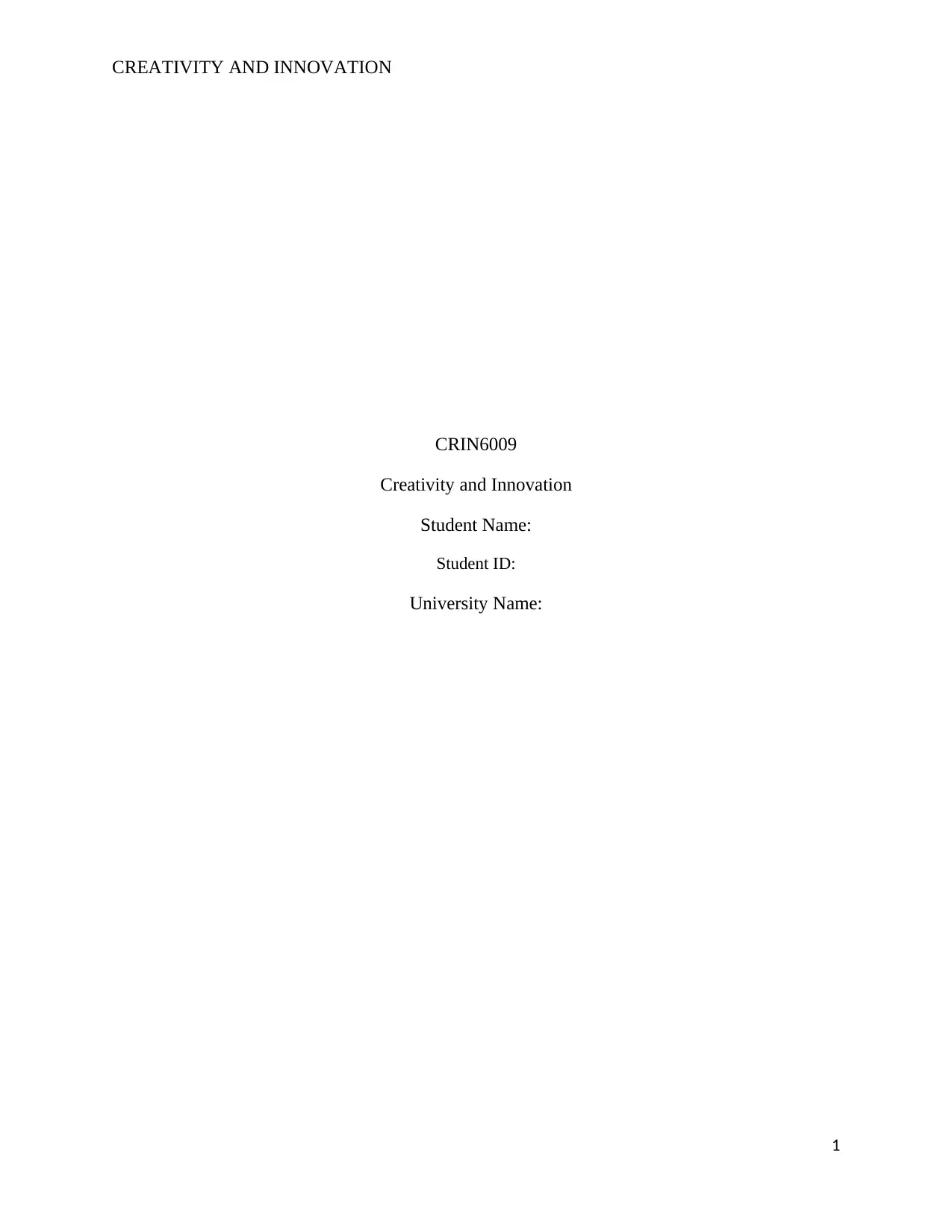
CREATIVITY AND INNOVATION
CRIN6009
Creativity and Innovation
Student Name:
Student ID:
University Name:
1
CRIN6009
Creativity and Innovation
Student Name:
Student ID:
University Name:
1
Paraphrase This Document
Need a fresh take? Get an instant paraphrase of this document with our AI Paraphraser
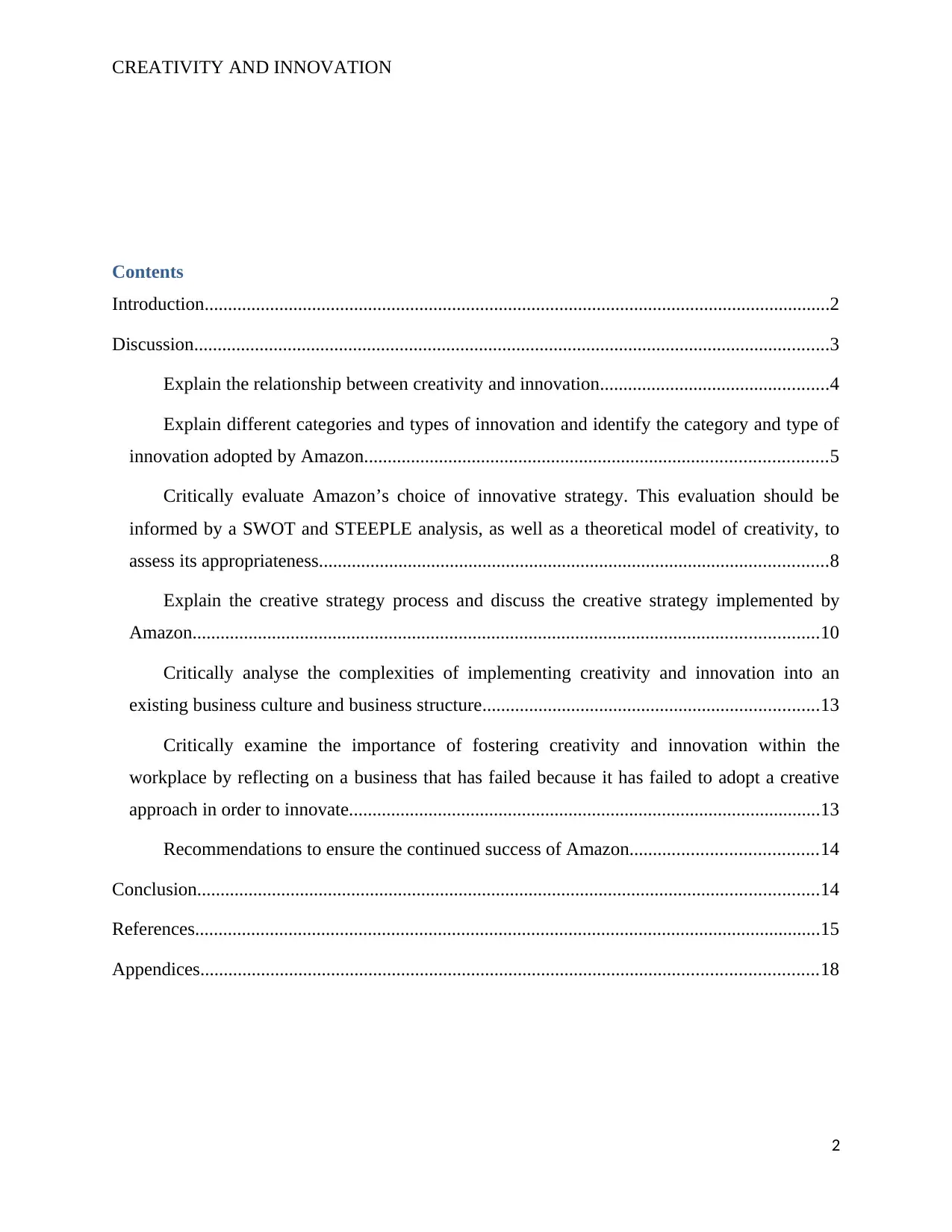
CREATIVITY AND INNOVATION
Contents
Introduction......................................................................................................................................2
Discussion........................................................................................................................................3
Explain the relationship between creativity and innovation.................................................4
Explain different categories and types of innovation and identify the category and type of
innovation adopted by Amazon...................................................................................................5
Critically evaluate Amazon’s choice of innovative strategy. This evaluation should be
informed by a SWOT and STEEPLE analysis, as well as a theoretical model of creativity, to
assess its appropriateness.............................................................................................................8
Explain the creative strategy process and discuss the creative strategy implemented by
Amazon......................................................................................................................................10
Critically analyse the complexities of implementing creativity and innovation into an
existing business culture and business structure........................................................................13
Critically examine the importance of fostering creativity and innovation within the
workplace by reflecting on a business that has failed because it has failed to adopt a creative
approach in order to innovate.....................................................................................................13
Recommendations to ensure the continued success of Amazon........................................14
Conclusion.....................................................................................................................................14
References......................................................................................................................................15
Appendices....................................................................................................................................18
2
Contents
Introduction......................................................................................................................................2
Discussion........................................................................................................................................3
Explain the relationship between creativity and innovation.................................................4
Explain different categories and types of innovation and identify the category and type of
innovation adopted by Amazon...................................................................................................5
Critically evaluate Amazon’s choice of innovative strategy. This evaluation should be
informed by a SWOT and STEEPLE analysis, as well as a theoretical model of creativity, to
assess its appropriateness.............................................................................................................8
Explain the creative strategy process and discuss the creative strategy implemented by
Amazon......................................................................................................................................10
Critically analyse the complexities of implementing creativity and innovation into an
existing business culture and business structure........................................................................13
Critically examine the importance of fostering creativity and innovation within the
workplace by reflecting on a business that has failed because it has failed to adopt a creative
approach in order to innovate.....................................................................................................13
Recommendations to ensure the continued success of Amazon........................................14
Conclusion.....................................................................................................................................14
References......................................................................................................................................15
Appendices....................................................................................................................................18
2
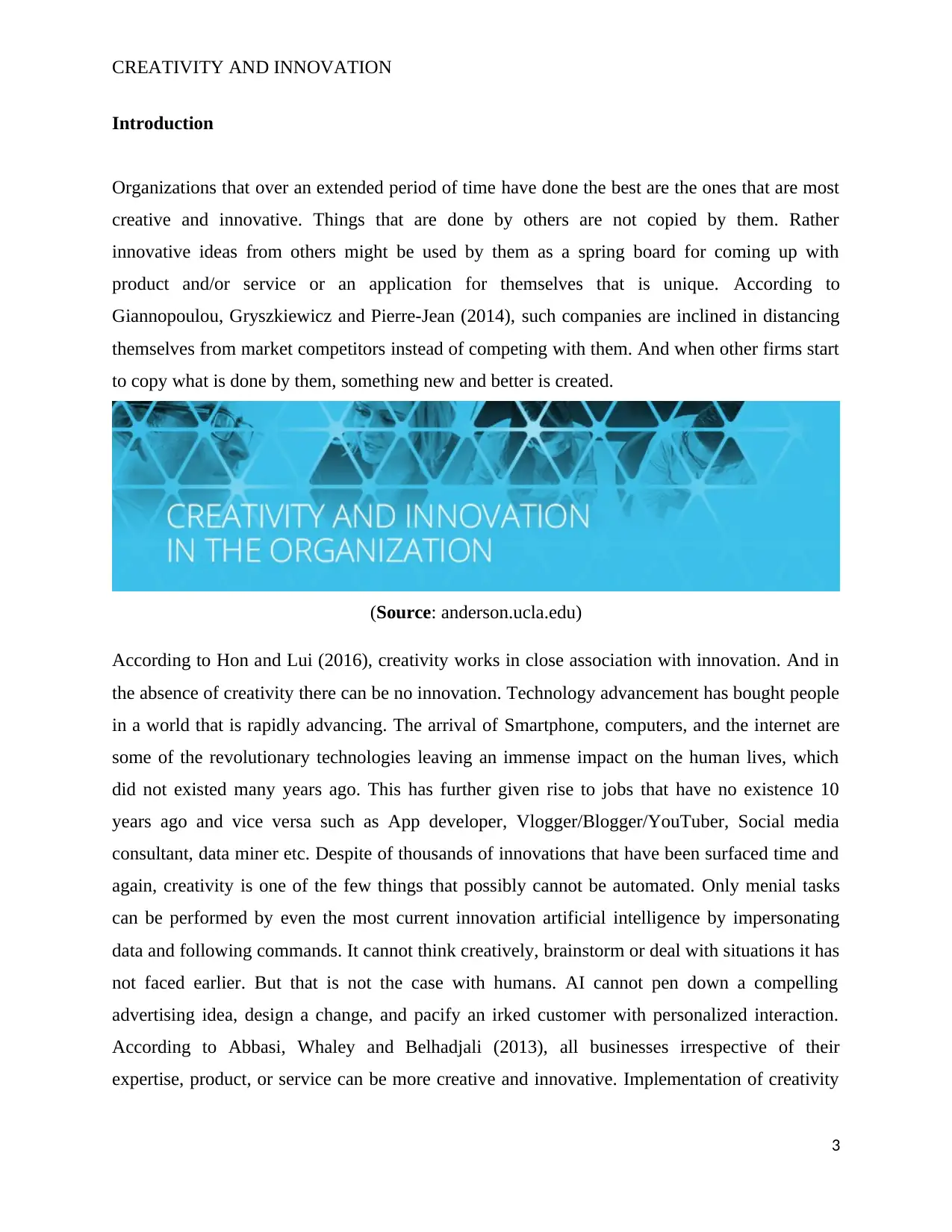
CREATIVITY AND INNOVATION
Introduction
Organizations that over an extended period of time have done the best are the ones that are most
creative and innovative. Things that are done by others are not copied by them. Rather
innovative ideas from others might be used by them as a spring board for coming up with
product and/or service or an application for themselves that is unique. According to
Giannopoulou, Gryszkiewicz and Pierre-Jean (2014), such companies are inclined in distancing
themselves from market competitors instead of competing with them. And when other firms start
to copy what is done by them, something new and better is created.
(Source: anderson.ucla.edu)
According to Hon and Lui (2016), creativity works in close association with innovation. And in
the absence of creativity there can be no innovation. Technology advancement has bought people
in a world that is rapidly advancing. The arrival of Smartphone, computers, and the internet are
some of the revolutionary technologies leaving an immense impact on the human lives, which
did not existed many years ago. This has further given rise to jobs that have no existence 10
years ago and vice versa such as App developer, Vlogger/Blogger/YouTuber, Social media
consultant, data miner etc. Despite of thousands of innovations that have been surfaced time and
again, creativity is one of the few things that possibly cannot be automated. Only menial tasks
can be performed by even the most current innovation artificial intelligence by impersonating
data and following commands. It cannot think creatively, brainstorm or deal with situations it has
not faced earlier. But that is not the case with humans. AI cannot pen down a compelling
advertising idea, design a change, and pacify an irked customer with personalized interaction.
According to Abbasi, Whaley and Belhadjali (2013), all businesses irrespective of their
expertise, product, or service can be more creative and innovative. Implementation of creativity
3
Introduction
Organizations that over an extended period of time have done the best are the ones that are most
creative and innovative. Things that are done by others are not copied by them. Rather
innovative ideas from others might be used by them as a spring board for coming up with
product and/or service or an application for themselves that is unique. According to
Giannopoulou, Gryszkiewicz and Pierre-Jean (2014), such companies are inclined in distancing
themselves from market competitors instead of competing with them. And when other firms start
to copy what is done by them, something new and better is created.
(Source: anderson.ucla.edu)
According to Hon and Lui (2016), creativity works in close association with innovation. And in
the absence of creativity there can be no innovation. Technology advancement has bought people
in a world that is rapidly advancing. The arrival of Smartphone, computers, and the internet are
some of the revolutionary technologies leaving an immense impact on the human lives, which
did not existed many years ago. This has further given rise to jobs that have no existence 10
years ago and vice versa such as App developer, Vlogger/Blogger/YouTuber, Social media
consultant, data miner etc. Despite of thousands of innovations that have been surfaced time and
again, creativity is one of the few things that possibly cannot be automated. Only menial tasks
can be performed by even the most current innovation artificial intelligence by impersonating
data and following commands. It cannot think creatively, brainstorm or deal with situations it has
not faced earlier. But that is not the case with humans. AI cannot pen down a compelling
advertising idea, design a change, and pacify an irked customer with personalized interaction.
According to Abbasi, Whaley and Belhadjali (2013), all businesses irrespective of their
expertise, product, or service can be more creative and innovative. Implementation of creativity
3
⊘ This is a preview!⊘
Do you want full access?
Subscribe today to unlock all pages.

Trusted by 1+ million students worldwide
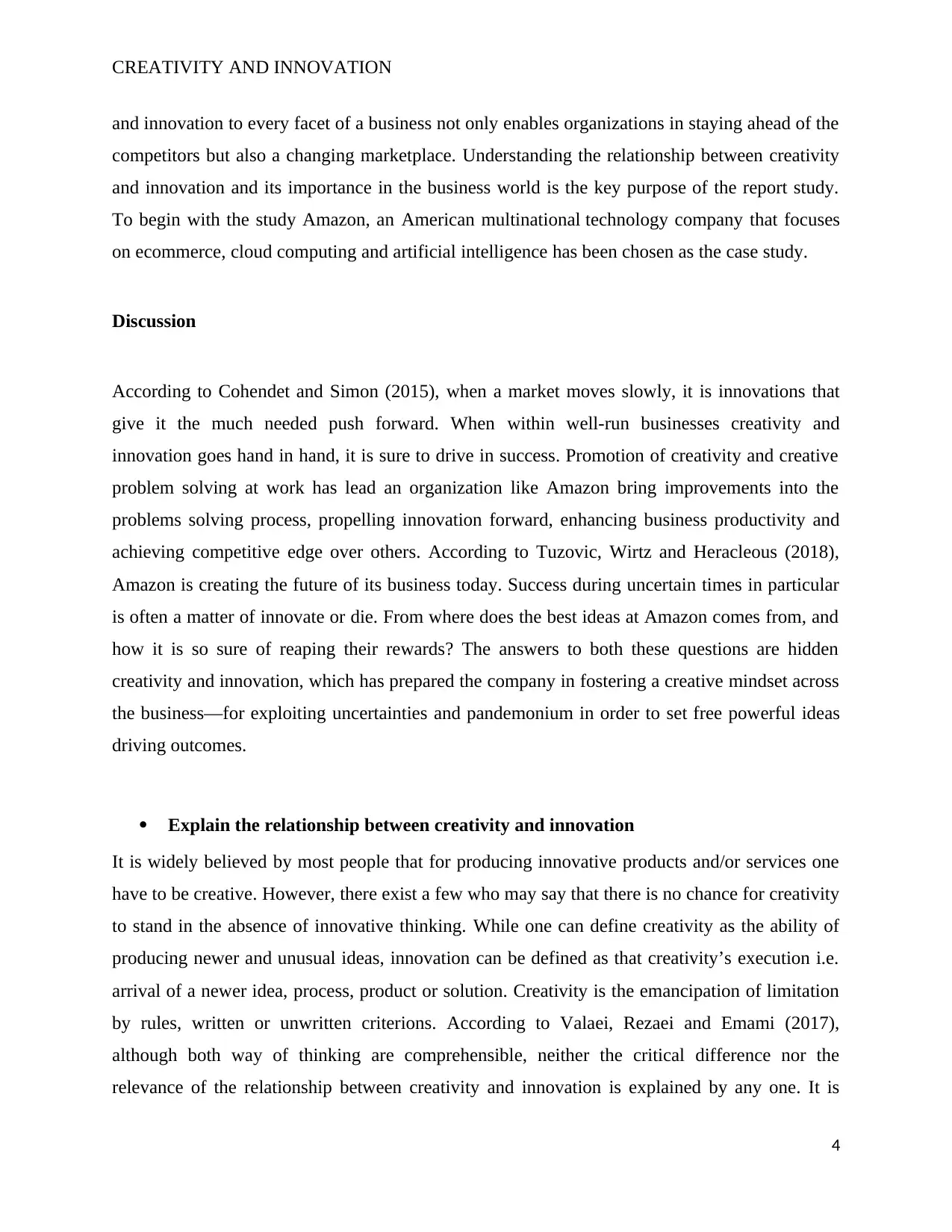
CREATIVITY AND INNOVATION
and innovation to every facet of a business not only enables organizations in staying ahead of the
competitors but also a changing marketplace. Understanding the relationship between creativity
and innovation and its importance in the business world is the key purpose of the report study.
To begin with the study Amazon, an American multinational technology company that focuses
on ecommerce, cloud computing and artificial intelligence has been chosen as the case study.
Discussion
According to Cohendet and Simon (2015), when a market moves slowly, it is innovations that
give it the much needed push forward. When within well-run businesses creativity and
innovation goes hand in hand, it is sure to drive in success. Promotion of creativity and creative
problem solving at work has lead an organization like Amazon bring improvements into the
problems solving process, propelling innovation forward, enhancing business productivity and
achieving competitive edge over others. According to Tuzovic, Wirtz and Heracleous (2018),
Amazon is creating the future of its business today. Success during uncertain times in particular
is often a matter of innovate or die. From where does the best ideas at Amazon comes from, and
how it is so sure of reaping their rewards? The answers to both these questions are hidden
creativity and innovation, which has prepared the company in fostering a creative mindset across
the business—for exploiting uncertainties and pandemonium in order to set free powerful ideas
driving outcomes.
Explain the relationship between creativity and innovation
It is widely believed by most people that for producing innovative products and/or services one
have to be creative. However, there exist a few who may say that there is no chance for creativity
to stand in the absence of innovative thinking. While one can define creativity as the ability of
producing newer and unusual ideas, innovation can be defined as that creativity’s execution i.e.
arrival of a newer idea, process, product or solution. Creativity is the emancipation of limitation
by rules, written or unwritten criterions. According to Valaei, Rezaei and Emami (2017),
although both way of thinking are comprehensible, neither the critical difference nor the
relevance of the relationship between creativity and innovation is explained by any one. It is
4
and innovation to every facet of a business not only enables organizations in staying ahead of the
competitors but also a changing marketplace. Understanding the relationship between creativity
and innovation and its importance in the business world is the key purpose of the report study.
To begin with the study Amazon, an American multinational technology company that focuses
on ecommerce, cloud computing and artificial intelligence has been chosen as the case study.
Discussion
According to Cohendet and Simon (2015), when a market moves slowly, it is innovations that
give it the much needed push forward. When within well-run businesses creativity and
innovation goes hand in hand, it is sure to drive in success. Promotion of creativity and creative
problem solving at work has lead an organization like Amazon bring improvements into the
problems solving process, propelling innovation forward, enhancing business productivity and
achieving competitive edge over others. According to Tuzovic, Wirtz and Heracleous (2018),
Amazon is creating the future of its business today. Success during uncertain times in particular
is often a matter of innovate or die. From where does the best ideas at Amazon comes from, and
how it is so sure of reaping their rewards? The answers to both these questions are hidden
creativity and innovation, which has prepared the company in fostering a creative mindset across
the business—for exploiting uncertainties and pandemonium in order to set free powerful ideas
driving outcomes.
Explain the relationship between creativity and innovation
It is widely believed by most people that for producing innovative products and/or services one
have to be creative. However, there exist a few who may say that there is no chance for creativity
to stand in the absence of innovative thinking. While one can define creativity as the ability of
producing newer and unusual ideas, innovation can be defined as that creativity’s execution i.e.
arrival of a newer idea, process, product or solution. Creativity is the emancipation of limitation
by rules, written or unwritten criterions. According to Valaei, Rezaei and Emami (2017),
although both way of thinking are comprehensible, neither the critical difference nor the
relevance of the relationship between creativity and innovation is explained by any one. It is
4
Paraphrase This Document
Need a fresh take? Get an instant paraphrase of this document with our AI Paraphraser
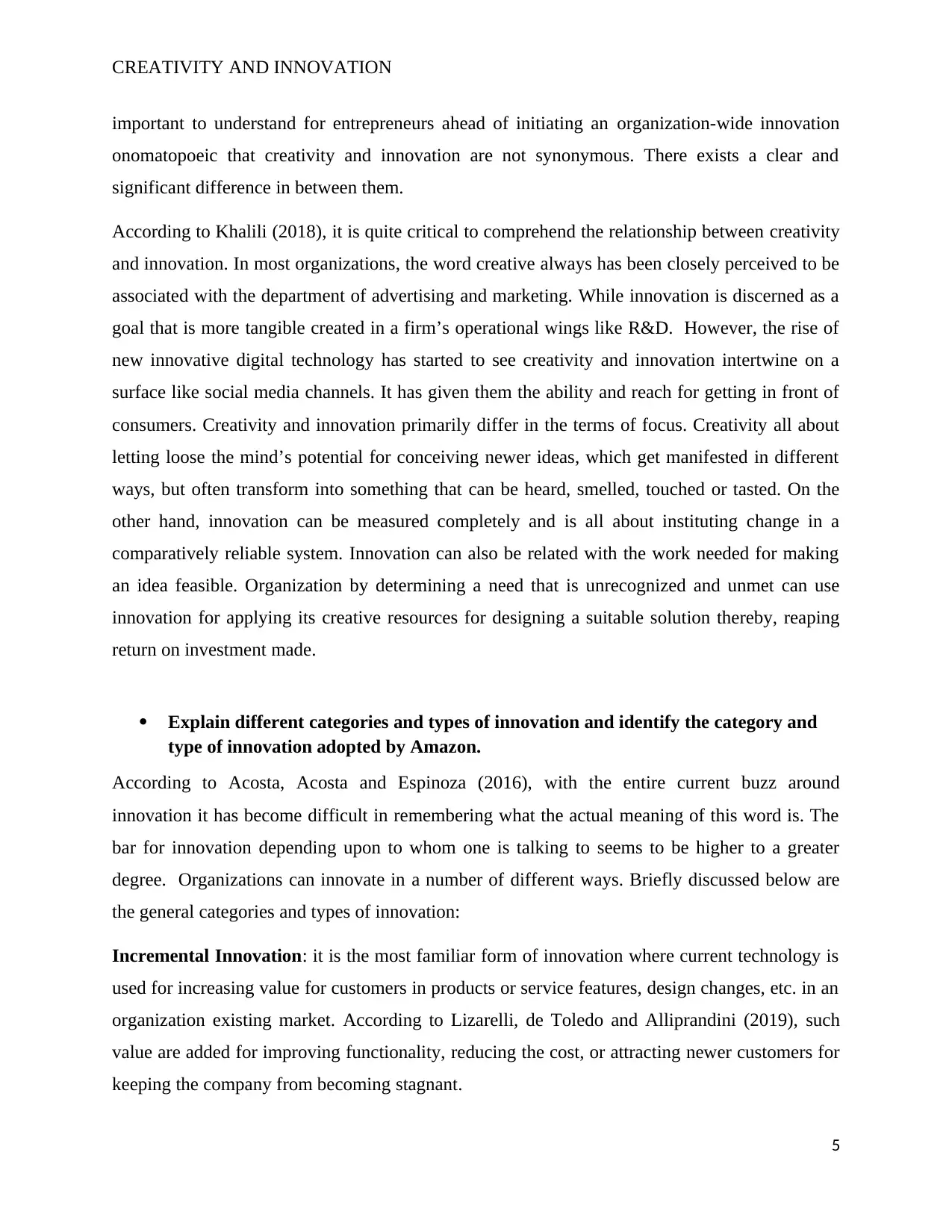
CREATIVITY AND INNOVATION
important to understand for entrepreneurs ahead of initiating an organization-wide innovation
onomatopoeic that creativity and innovation are not synonymous. There exists a clear and
significant difference in between them.
According to Khalili (2018), it is quite critical to comprehend the relationship between creativity
and innovation. In most organizations, the word creative always has been closely perceived to be
associated with the department of advertising and marketing. While innovation is discerned as a
goal that is more tangible created in a firm’s operational wings like R&D. However, the rise of
new innovative digital technology has started to see creativity and innovation intertwine on a
surface like social media channels. It has given them the ability and reach for getting in front of
consumers. Creativity and innovation primarily differ in the terms of focus. Creativity all about
letting loose the mind’s potential for conceiving newer ideas, which get manifested in different
ways, but often transform into something that can be heard, smelled, touched or tasted. On the
other hand, innovation can be measured completely and is all about instituting change in a
comparatively reliable system. Innovation can also be related with the work needed for making
an idea feasible. Organization by determining a need that is unrecognized and unmet can use
innovation for applying its creative resources for designing a suitable solution thereby, reaping
return on investment made.
Explain different categories and types of innovation and identify the category and
type of innovation adopted by Amazon.
According to Acosta, Acosta and Espinoza (2016), with the entire current buzz around
innovation it has become difficult in remembering what the actual meaning of this word is. The
bar for innovation depending upon to whom one is talking to seems to be higher to a greater
degree. Organizations can innovate in a number of different ways. Briefly discussed below are
the general categories and types of innovation:
Incremental Innovation: it is the most familiar form of innovation where current technology is
used for increasing value for customers in products or service features, design changes, etc. in an
organization existing market. According to Lizarelli, de Toledo and Alliprandini (2019), such
value are added for improving functionality, reducing the cost, or attracting newer customers for
keeping the company from becoming stagnant.
5
important to understand for entrepreneurs ahead of initiating an organization-wide innovation
onomatopoeic that creativity and innovation are not synonymous. There exists a clear and
significant difference in between them.
According to Khalili (2018), it is quite critical to comprehend the relationship between creativity
and innovation. In most organizations, the word creative always has been closely perceived to be
associated with the department of advertising and marketing. While innovation is discerned as a
goal that is more tangible created in a firm’s operational wings like R&D. However, the rise of
new innovative digital technology has started to see creativity and innovation intertwine on a
surface like social media channels. It has given them the ability and reach for getting in front of
consumers. Creativity and innovation primarily differ in the terms of focus. Creativity all about
letting loose the mind’s potential for conceiving newer ideas, which get manifested in different
ways, but often transform into something that can be heard, smelled, touched or tasted. On the
other hand, innovation can be measured completely and is all about instituting change in a
comparatively reliable system. Innovation can also be related with the work needed for making
an idea feasible. Organization by determining a need that is unrecognized and unmet can use
innovation for applying its creative resources for designing a suitable solution thereby, reaping
return on investment made.
Explain different categories and types of innovation and identify the category and
type of innovation adopted by Amazon.
According to Acosta, Acosta and Espinoza (2016), with the entire current buzz around
innovation it has become difficult in remembering what the actual meaning of this word is. The
bar for innovation depending upon to whom one is talking to seems to be higher to a greater
degree. Organizations can innovate in a number of different ways. Briefly discussed below are
the general categories and types of innovation:
Incremental Innovation: it is the most familiar form of innovation where current technology is
used for increasing value for customers in products or service features, design changes, etc. in an
organization existing market. According to Lizarelli, de Toledo and Alliprandini (2019), such
value are added for improving functionality, reducing the cost, or attracting newer customers for
keeping the company from becoming stagnant.
5
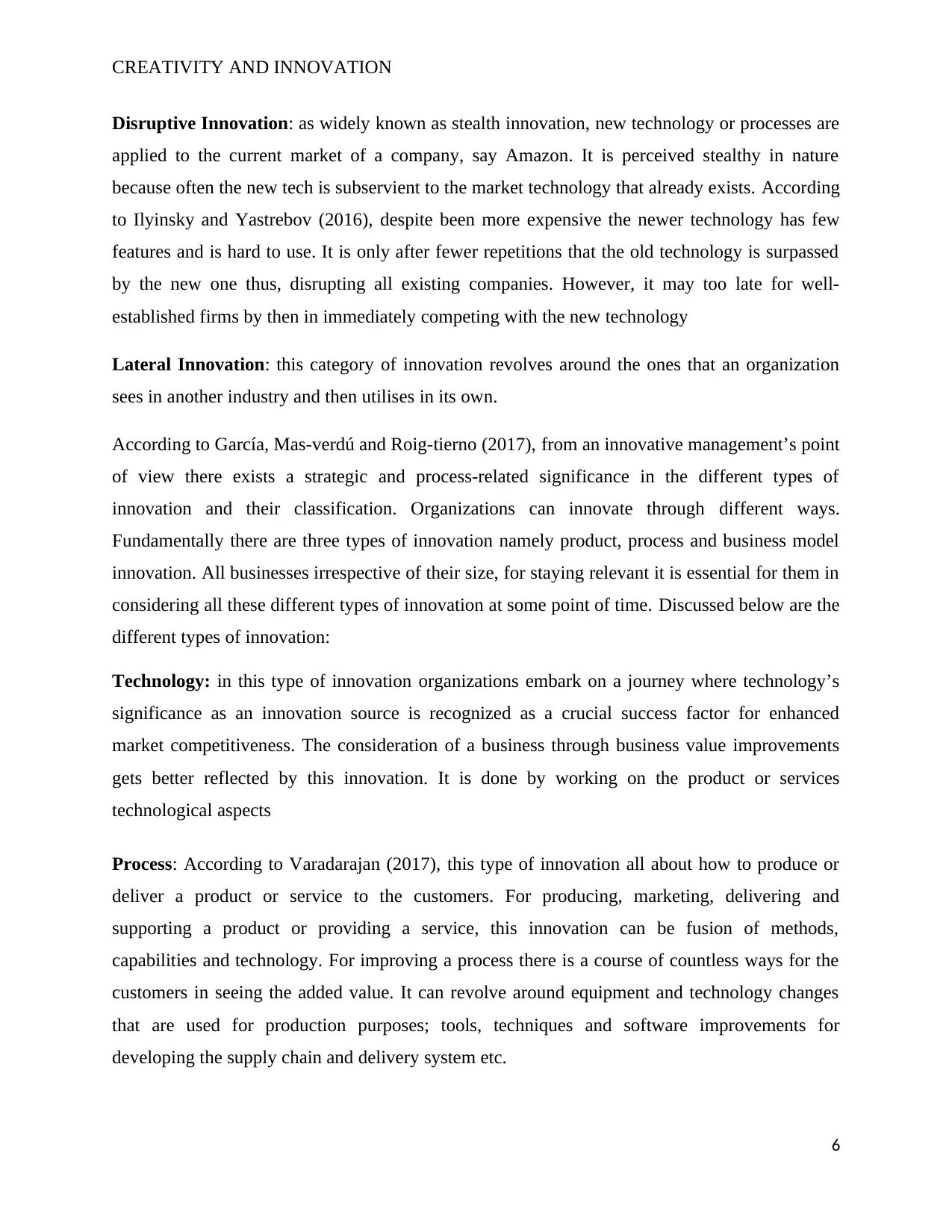
CREATIVITY AND INNOVATION
Disruptive Innovation: as widely known as stealth innovation, new technology or processes are
applied to the current market of a company, say Amazon. It is perceived stealthy in nature
because often the new tech is subservient to the market technology that already exists. According
to Ilyinsky and Yastrebov (2016), despite been more expensive the newer technology has few
features and is hard to use. It is only after fewer repetitions that the old technology is surpassed
by the new one thus, disrupting all existing companies. However, it may too late for well-
established firms by then in immediately competing with the new technology
Lateral Innovation: this category of innovation revolves around the ones that an organization
sees in another industry and then utilises in its own.
According to García, Mas-verdú and Roig-tierno (2017), from an innovative management’s point
of view there exists a strategic and process-related significance in the different types of
innovation and their classification. Organizations can innovate through different ways.
Fundamentally there are three types of innovation namely product, process and business model
innovation. All businesses irrespective of their size, for staying relevant it is essential for them in
considering all these different types of innovation at some point of time. Discussed below are the
different types of innovation:
Technology: in this type of innovation organizations embark on a journey where technology’s
significance as an innovation source is recognized as a crucial success factor for enhanced
market competitiveness. The consideration of a business through business value improvements
gets better reflected by this innovation. It is done by working on the product or services
technological aspects
Process: According to Varadarajan (2017), this type of innovation all about how to produce or
deliver a product or service to the customers. For producing, marketing, delivering and
supporting a product or providing a service, this innovation can be fusion of methods,
capabilities and technology. For improving a process there is a course of countless ways for the
customers in seeing the added value. It can revolve around equipment and technology changes
that are used for production purposes; tools, techniques and software improvements for
developing the supply chain and delivery system etc.
6
Disruptive Innovation: as widely known as stealth innovation, new technology or processes are
applied to the current market of a company, say Amazon. It is perceived stealthy in nature
because often the new tech is subservient to the market technology that already exists. According
to Ilyinsky and Yastrebov (2016), despite been more expensive the newer technology has few
features and is hard to use. It is only after fewer repetitions that the old technology is surpassed
by the new one thus, disrupting all existing companies. However, it may too late for well-
established firms by then in immediately competing with the new technology
Lateral Innovation: this category of innovation revolves around the ones that an organization
sees in another industry and then utilises in its own.
According to García, Mas-verdú and Roig-tierno (2017), from an innovative management’s point
of view there exists a strategic and process-related significance in the different types of
innovation and their classification. Organizations can innovate through different ways.
Fundamentally there are three types of innovation namely product, process and business model
innovation. All businesses irrespective of their size, for staying relevant it is essential for them in
considering all these different types of innovation at some point of time. Discussed below are the
different types of innovation:
Technology: in this type of innovation organizations embark on a journey where technology’s
significance as an innovation source is recognized as a crucial success factor for enhanced
market competitiveness. The consideration of a business through business value improvements
gets better reflected by this innovation. It is done by working on the product or services
technological aspects
Process: According to Varadarajan (2017), this type of innovation all about how to produce or
deliver a product or service to the customers. For producing, marketing, delivering and
supporting a product or providing a service, this innovation can be fusion of methods,
capabilities and technology. For improving a process there is a course of countless ways for the
customers in seeing the added value. It can revolve around equipment and technology changes
that are used for production purposes; tools, techniques and software improvements for
developing the supply chain and delivery system etc.
6
⊘ This is a preview!⊘
Do you want full access?
Subscribe today to unlock all pages.

Trusted by 1+ million students worldwide
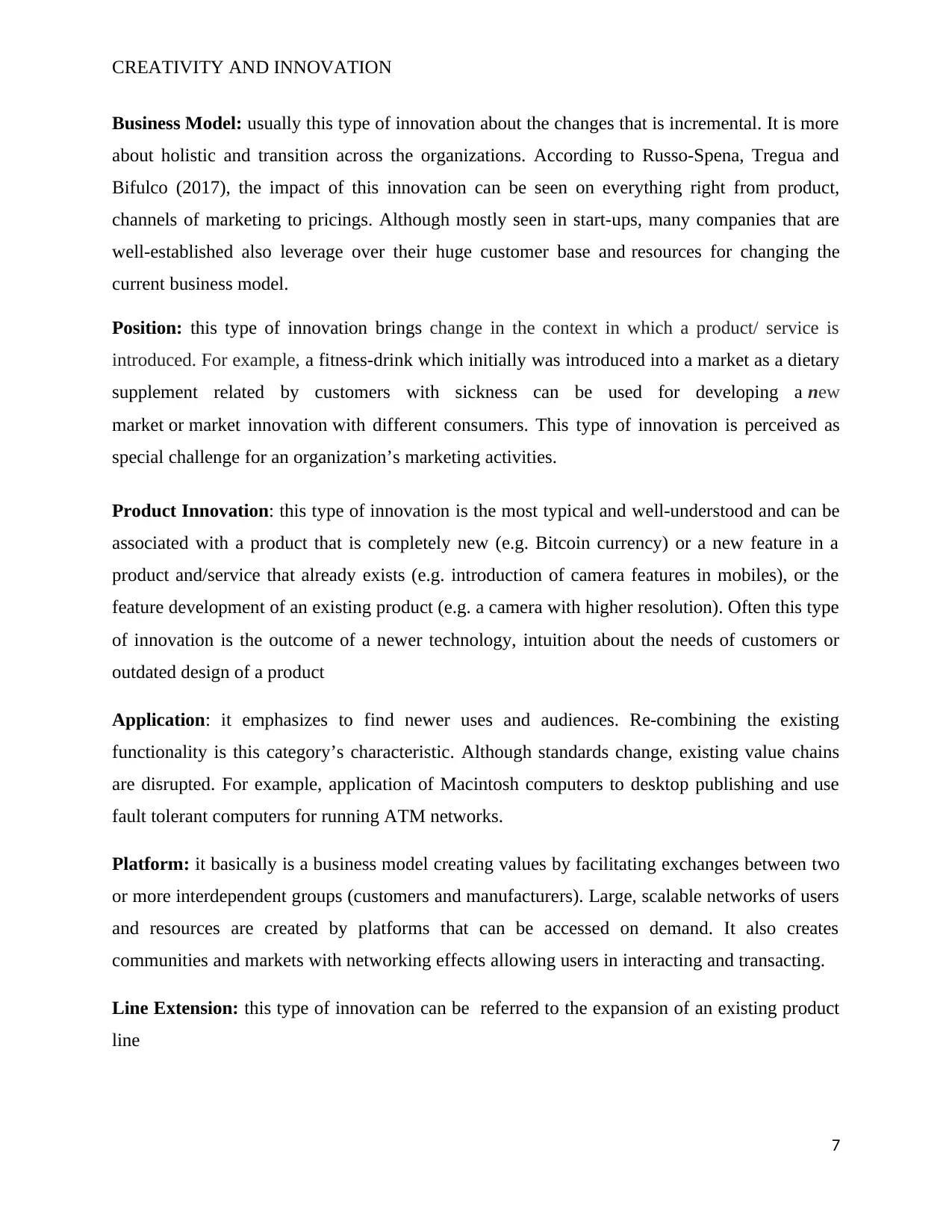
CREATIVITY AND INNOVATION
Business Model: usually this type of innovation about the changes that is incremental. It is more
about holistic and transition across the organizations. According to Russo-Spena, Tregua and
Bifulco (2017), the impact of this innovation can be seen on everything right from product,
channels of marketing to pricings. Although mostly seen in start-ups, many companies that are
well-established also leverage over their huge customer base and resources for changing the
current business model.
Position: this type of innovation brings change in the context in which a product/ service is
introduced. For example, a fitness-drink which initially was introduced into a market as a dietary
supplement related by customers with sickness can be used for developing a new
market or market innovation with different consumers. This type of innovation is perceived as
special challenge for an organization’s marketing activities.
Product Innovation: this type of innovation is the most typical and well-understood and can be
associated with a product that is completely new (e.g. Bitcoin currency) or a new feature in a
product and/service that already exists (e.g. introduction of camera features in mobiles), or the
feature development of an existing product (e.g. a camera with higher resolution). Often this type
of innovation is the outcome of a newer technology, intuition about the needs of customers or
outdated design of a product
Application: it emphasizes to find newer uses and audiences. Re-combining the existing
functionality is this category’s characteristic. Although standards change, existing value chains
are disrupted. For example, application of Macintosh computers to desktop publishing and use
fault tolerant computers for running ATM networks.
Platform: it basically is a business model creating values by facilitating exchanges between two
or more interdependent groups (customers and manufacturers). Large, scalable networks of users
and resources are created by platforms that can be accessed on demand. It also creates
communities and markets with networking effects allowing users in interacting and transacting.
Line Extension: this type of innovation can be referred to the expansion of an existing product
line
7
Business Model: usually this type of innovation about the changes that is incremental. It is more
about holistic and transition across the organizations. According to Russo-Spena, Tregua and
Bifulco (2017), the impact of this innovation can be seen on everything right from product,
channels of marketing to pricings. Although mostly seen in start-ups, many companies that are
well-established also leverage over their huge customer base and resources for changing the
current business model.
Position: this type of innovation brings change in the context in which a product/ service is
introduced. For example, a fitness-drink which initially was introduced into a market as a dietary
supplement related by customers with sickness can be used for developing a new
market or market innovation with different consumers. This type of innovation is perceived as
special challenge for an organization’s marketing activities.
Product Innovation: this type of innovation is the most typical and well-understood and can be
associated with a product that is completely new (e.g. Bitcoin currency) or a new feature in a
product and/service that already exists (e.g. introduction of camera features in mobiles), or the
feature development of an existing product (e.g. a camera with higher resolution). Often this type
of innovation is the outcome of a newer technology, intuition about the needs of customers or
outdated design of a product
Application: it emphasizes to find newer uses and audiences. Re-combining the existing
functionality is this category’s characteristic. Although standards change, existing value chains
are disrupted. For example, application of Macintosh computers to desktop publishing and use
fault tolerant computers for running ATM networks.
Platform: it basically is a business model creating values by facilitating exchanges between two
or more interdependent groups (customers and manufacturers). Large, scalable networks of users
and resources are created by platforms that can be accessed on demand. It also creates
communities and markets with networking effects allowing users in interacting and transacting.
Line Extension: this type of innovation can be referred to the expansion of an existing product
line
7
Paraphrase This Document
Need a fresh take? Get an instant paraphrase of this document with our AI Paraphraser
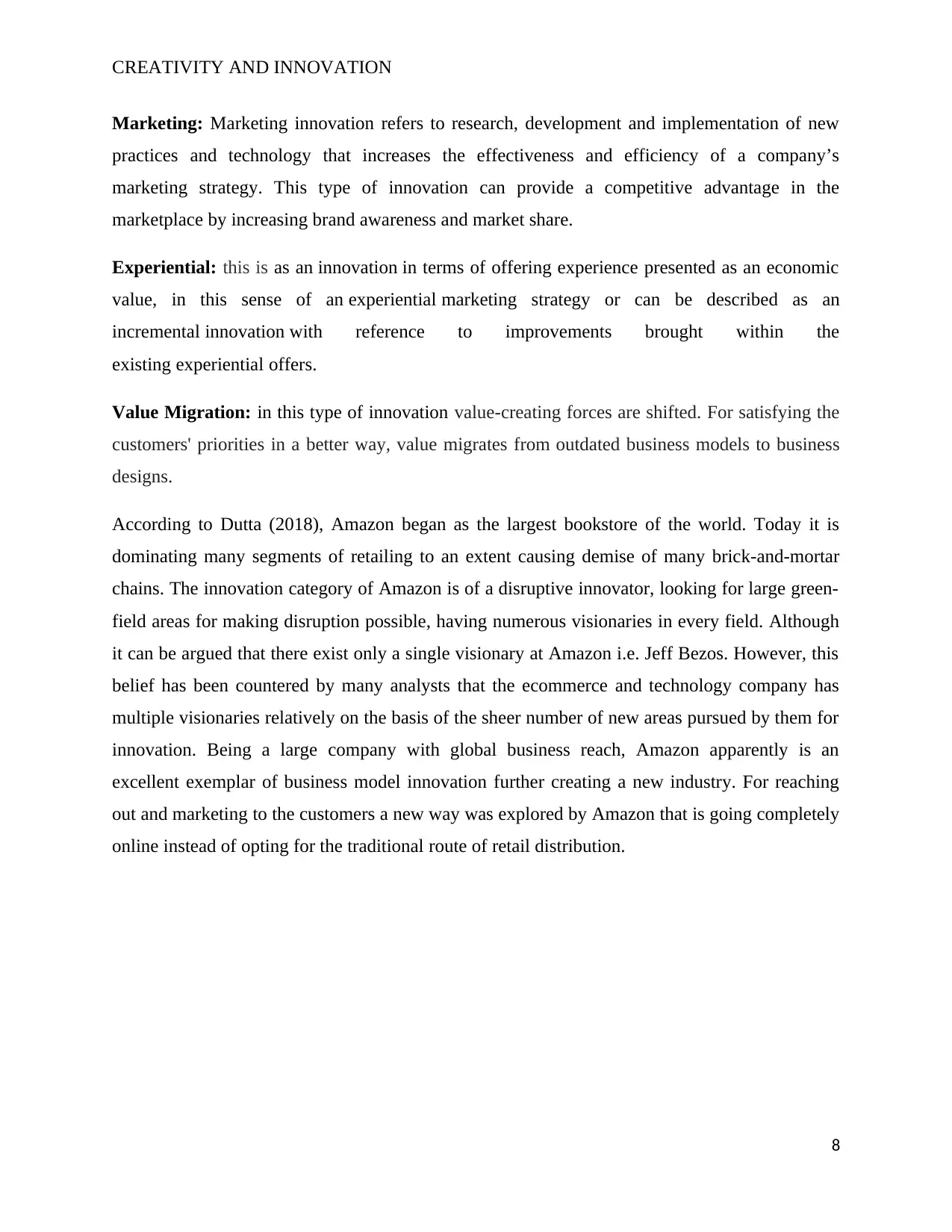
CREATIVITY AND INNOVATION
Marketing: Marketing innovation refers to research, development and implementation of new
practices and technology that increases the effectiveness and efficiency of a company’s
marketing strategy. This type of innovation can provide a competitive advantage in the
marketplace by increasing brand awareness and market share.
Experiential: this is as an innovation in terms of offering experience presented as an economic
value, in this sense of an experiential marketing strategy or can be described as an
incremental innovation with reference to improvements brought within the
existing experiential offers.
Value Migration: in this type of innovation value-creating forces are shifted. For satisfying the
customers' priorities in a better way, value migrates from outdated business models to business
designs.
According to Dutta (2018), Amazon began as the largest bookstore of the world. Today it is
dominating many segments of retailing to an extent causing demise of many brick-and-mortar
chains. The innovation category of Amazon is of a disruptive innovator, looking for large green-
field areas for making disruption possible, having numerous visionaries in every field. Although
it can be argued that there exist only a single visionary at Amazon i.e. Jeff Bezos. However, this
belief has been countered by many analysts that the ecommerce and technology company has
multiple visionaries relatively on the basis of the sheer number of new areas pursued by them for
innovation. Being a large company with global business reach, Amazon apparently is an
excellent exemplar of business model innovation further creating a new industry. For reaching
out and marketing to the customers a new way was explored by Amazon that is going completely
online instead of opting for the traditional route of retail distribution.
8
Marketing: Marketing innovation refers to research, development and implementation of new
practices and technology that increases the effectiveness and efficiency of a company’s
marketing strategy. This type of innovation can provide a competitive advantage in the
marketplace by increasing brand awareness and market share.
Experiential: this is as an innovation in terms of offering experience presented as an economic
value, in this sense of an experiential marketing strategy or can be described as an
incremental innovation with reference to improvements brought within the
existing experiential offers.
Value Migration: in this type of innovation value-creating forces are shifted. For satisfying the
customers' priorities in a better way, value migrates from outdated business models to business
designs.
According to Dutta (2018), Amazon began as the largest bookstore of the world. Today it is
dominating many segments of retailing to an extent causing demise of many brick-and-mortar
chains. The innovation category of Amazon is of a disruptive innovator, looking for large green-
field areas for making disruption possible, having numerous visionaries in every field. Although
it can be argued that there exist only a single visionary at Amazon i.e. Jeff Bezos. However, this
belief has been countered by many analysts that the ecommerce and technology company has
multiple visionaries relatively on the basis of the sheer number of new areas pursued by them for
innovation. Being a large company with global business reach, Amazon apparently is an
excellent exemplar of business model innovation further creating a new industry. For reaching
out and marketing to the customers a new way was explored by Amazon that is going completely
online instead of opting for the traditional route of retail distribution.
8
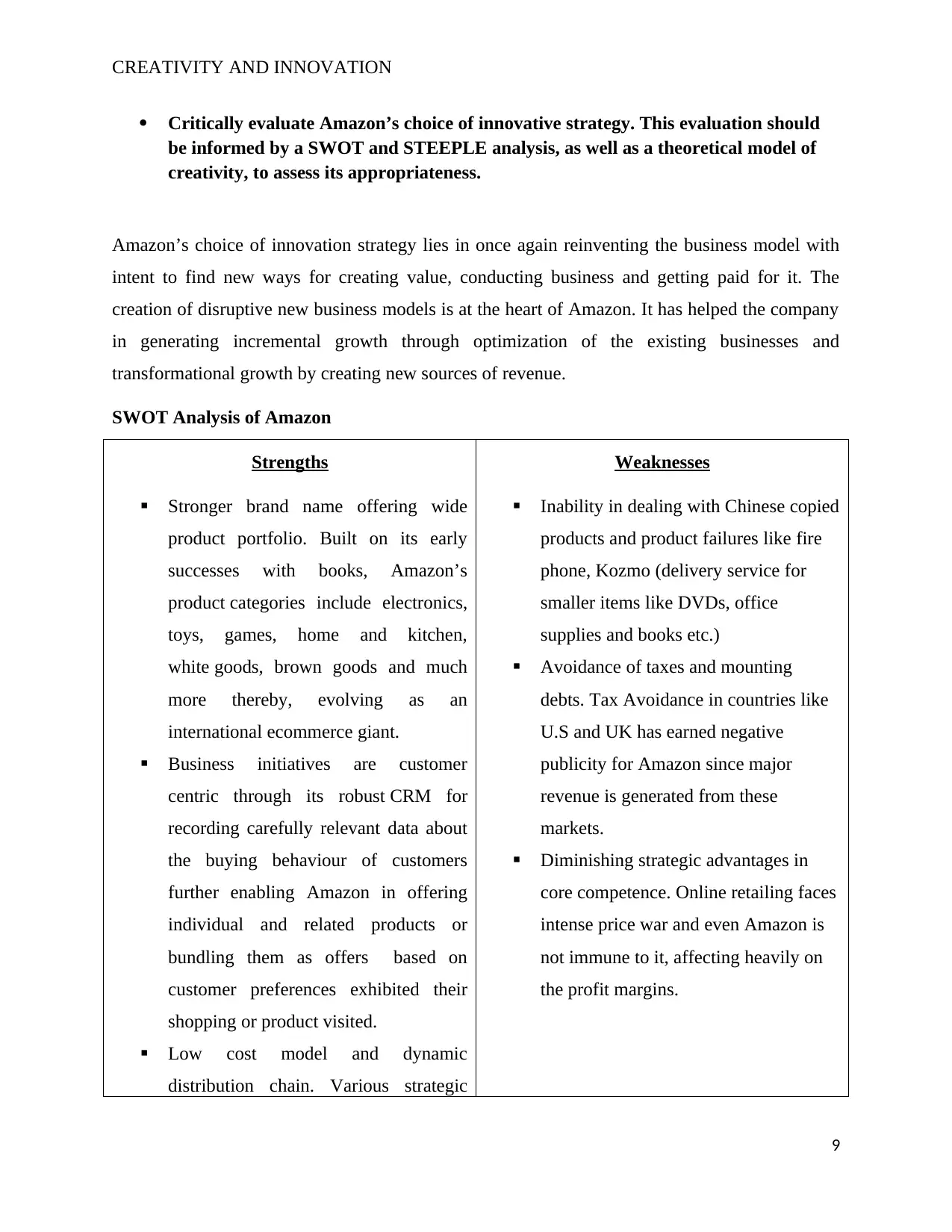
CREATIVITY AND INNOVATION
Critically evaluate Amazon’s choice of innovative strategy. This evaluation should
be informed by a SWOT and STEEPLE analysis, as well as a theoretical model of
creativity, to assess its appropriateness.
Amazon’s choice of innovation strategy lies in once again reinventing the business model with
intent to find new ways for creating value, conducting business and getting paid for it. The
creation of disruptive new business models is at the heart of Amazon. It has helped the company
in generating incremental growth through optimization of the existing businesses and
transformational growth by creating new sources of revenue.
SWOT Analysis of Amazon
Strengths
Stronger brand name offering wide
product portfolio. Built on its early
successes with books, Amazon’s
product categories include electronics,
toys, games, home and kitchen,
white goods, brown goods and much
more thereby, evolving as an
international ecommerce giant.
Business initiatives are customer
centric through its robust CRM for
recording carefully relevant data about
the buying behaviour of customers
further enabling Amazon in offering
individual and related products or
bundling them as offers based on
customer preferences exhibited their
shopping or product visited.
Low cost model and dynamic
distribution chain. Various strategic
Weaknesses
Inability in dealing with Chinese copied
products and product failures like fire
phone, Kozmo (delivery service for
smaller items like DVDs, office
supplies and books etc.)
Avoidance of taxes and mounting
debts. Tax Avoidance in countries like
U.S and UK has earned negative
publicity for Amazon since major
revenue is generated from these
markets.
Diminishing strategic advantages in
core competence. Online retailing faces
intense price war and even Amazon is
not immune to it, affecting heavily on
the profit margins.
9
Critically evaluate Amazon’s choice of innovative strategy. This evaluation should
be informed by a SWOT and STEEPLE analysis, as well as a theoretical model of
creativity, to assess its appropriateness.
Amazon’s choice of innovation strategy lies in once again reinventing the business model with
intent to find new ways for creating value, conducting business and getting paid for it. The
creation of disruptive new business models is at the heart of Amazon. It has helped the company
in generating incremental growth through optimization of the existing businesses and
transformational growth by creating new sources of revenue.
SWOT Analysis of Amazon
Strengths
Stronger brand name offering wide
product portfolio. Built on its early
successes with books, Amazon’s
product categories include electronics,
toys, games, home and kitchen,
white goods, brown goods and much
more thereby, evolving as an
international ecommerce giant.
Business initiatives are customer
centric through its robust CRM for
recording carefully relevant data about
the buying behaviour of customers
further enabling Amazon in offering
individual and related products or
bundling them as offers based on
customer preferences exhibited their
shopping or product visited.
Low cost model and dynamic
distribution chain. Various strategic
Weaknesses
Inability in dealing with Chinese copied
products and product failures like fire
phone, Kozmo (delivery service for
smaller items like DVDs, office
supplies and books etc.)
Avoidance of taxes and mounting
debts. Tax Avoidance in countries like
U.S and UK has earned negative
publicity for Amazon since major
revenue is generated from these
markets.
Diminishing strategic advantages in
core competence. Online retailing faces
intense price war and even Amazon is
not immune to it, affecting heavily on
the profit margins.
9
⊘ This is a preview!⊘
Do you want full access?
Subscribe today to unlock all pages.

Trusted by 1+ million students worldwide
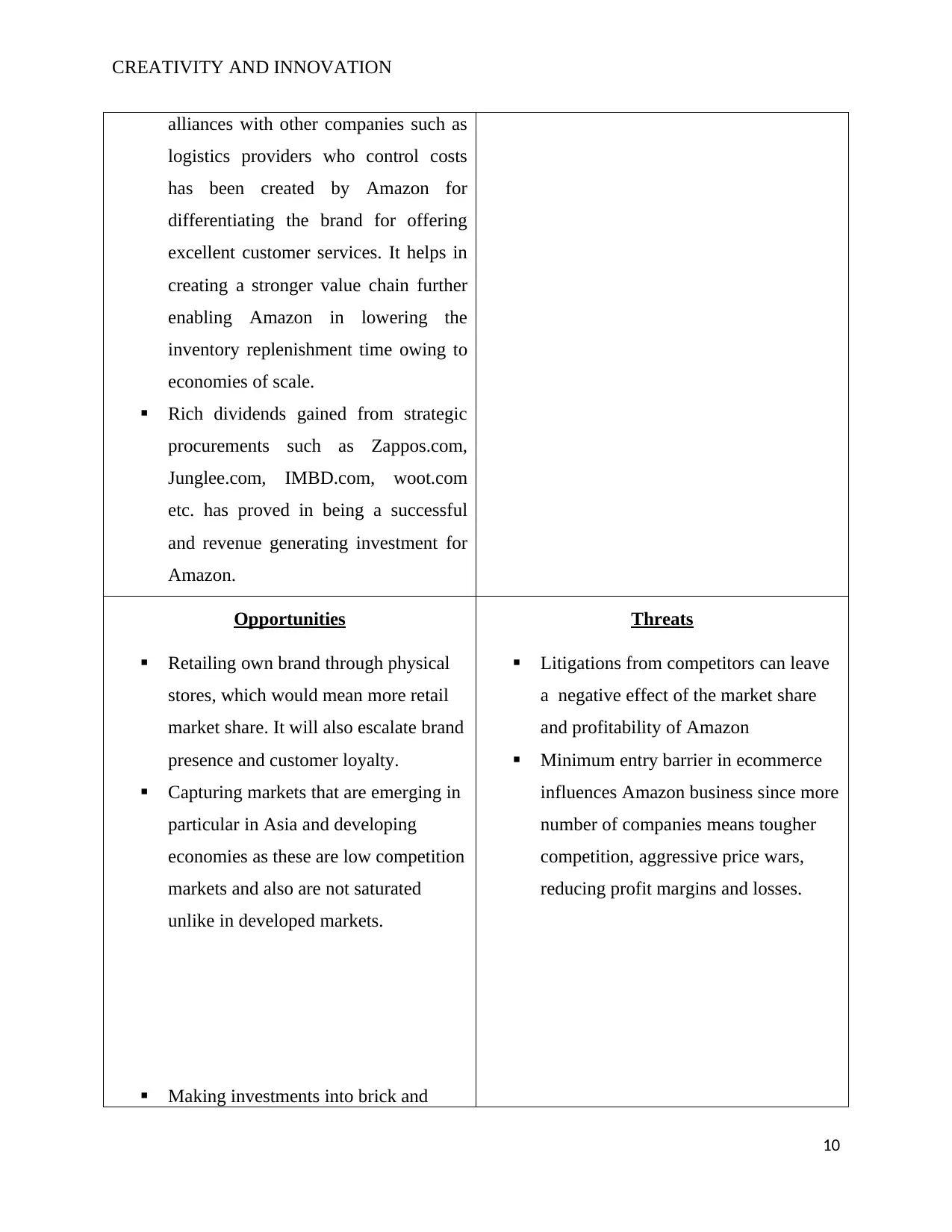
CREATIVITY AND INNOVATION
alliances with other companies such as
logistics providers who control costs
has been created by Amazon for
differentiating the brand for offering
excellent customer services. It helps in
creating a stronger value chain further
enabling Amazon in lowering the
inventory replenishment time owing to
economies of scale.
Rich dividends gained from strategic
procurements such as Zappos.com,
Junglee.com, IMBD.com, woot.com
etc. has proved in being a successful
and revenue generating investment for
Amazon.
Opportunities
Retailing own brand through physical
stores, which would mean more retail
market share. It will also escalate brand
presence and customer loyalty.
Capturing markets that are emerging in
particular in Asia and developing
economies as these are low competition
markets and also are not saturated
unlike in developed markets.
Making investments into brick and
Threats
Litigations from competitors can leave
a negative effect of the market share
and profitability of Amazon
Minimum entry barrier in ecommerce
influences Amazon business since more
number of companies means tougher
competition, aggressive price wars,
reducing profit margins and losses.
10
alliances with other companies such as
logistics providers who control costs
has been created by Amazon for
differentiating the brand for offering
excellent customer services. It helps in
creating a stronger value chain further
enabling Amazon in lowering the
inventory replenishment time owing to
economies of scale.
Rich dividends gained from strategic
procurements such as Zappos.com,
Junglee.com, IMBD.com, woot.com
etc. has proved in being a successful
and revenue generating investment for
Amazon.
Opportunities
Retailing own brand through physical
stores, which would mean more retail
market share. It will also escalate brand
presence and customer loyalty.
Capturing markets that are emerging in
particular in Asia and developing
economies as these are low competition
markets and also are not saturated
unlike in developed markets.
Making investments into brick and
Threats
Litigations from competitors can leave
a negative effect of the market share
and profitability of Amazon
Minimum entry barrier in ecommerce
influences Amazon business since more
number of companies means tougher
competition, aggressive price wars,
reducing profit margins and losses.
10
Paraphrase This Document
Need a fresh take? Get an instant paraphrase of this document with our AI Paraphraser
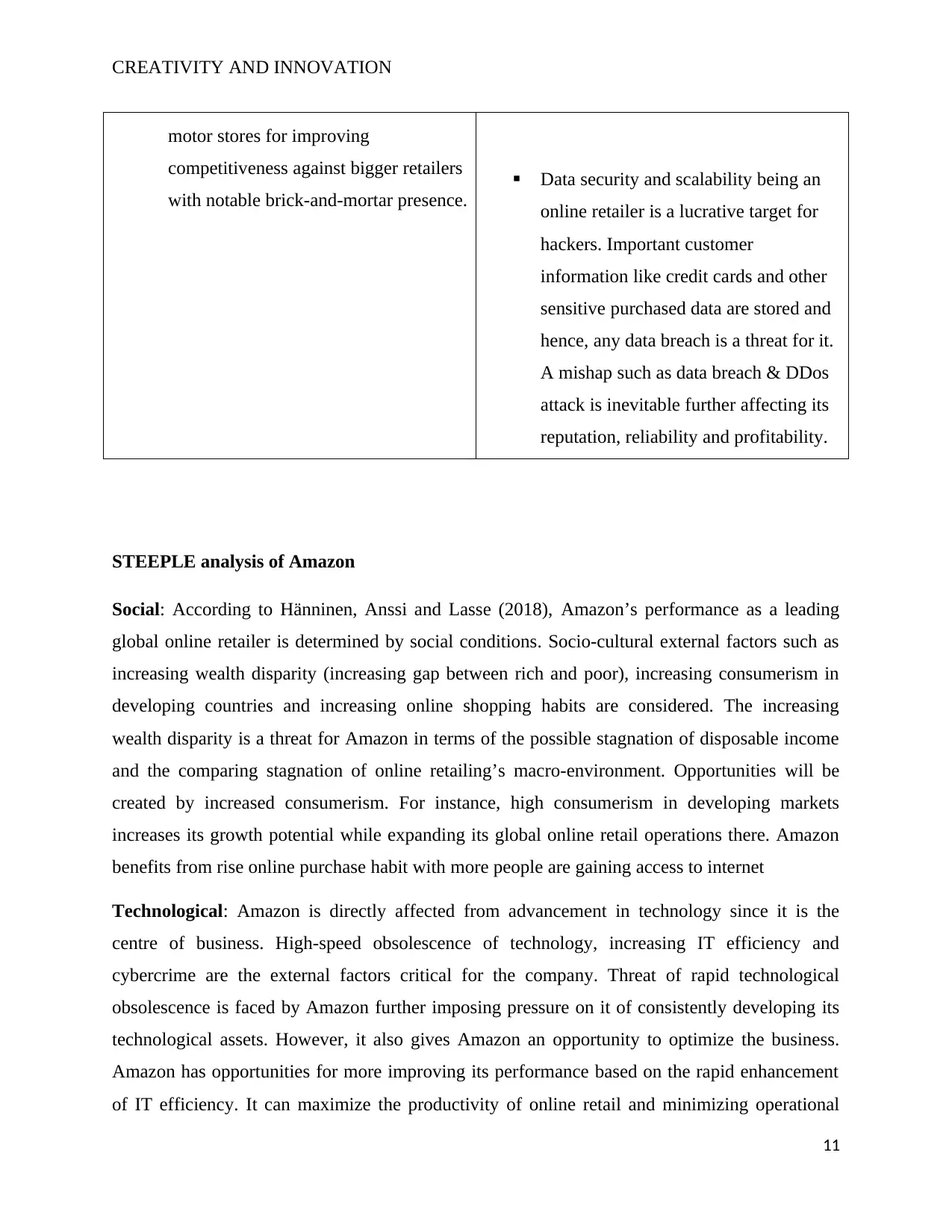
CREATIVITY AND INNOVATION
motor stores for improving
competitiveness against bigger retailers
with notable brick-and-mortar presence.
Data security and scalability being an
online retailer is a lucrative target for
hackers. Important customer
information like credit cards and other
sensitive purchased data are stored and
hence, any data breach is a threat for it.
A mishap such as data breach & DDos
attack is inevitable further affecting its
reputation, reliability and profitability.
STEEPLE analysis of Amazon
Social: According to Hänninen, Anssi and Lasse (2018), Amazon’s performance as a leading
global online retailer is determined by social conditions. Socio-cultural external factors such as
increasing wealth disparity (increasing gap between rich and poor), increasing consumerism in
developing countries and increasing online shopping habits are considered. The increasing
wealth disparity is a threat for Amazon in terms of the possible stagnation of disposable income
and the comparing stagnation of online retailing’s macro-environment. Opportunities will be
created by increased consumerism. For instance, high consumerism in developing markets
increases its growth potential while expanding its global online retail operations there. Amazon
benefits from rise online purchase habit with more people are gaining access to internet
Technological: Amazon is directly affected from advancement in technology since it is the
centre of business. High-speed obsolescence of technology, increasing IT efficiency and
cybercrime are the external factors critical for the company. Threat of rapid technological
obsolescence is faced by Amazon further imposing pressure on it of consistently developing its
technological assets. However, it also gives Amazon an opportunity to optimize the business.
Amazon has opportunities for more improving its performance based on the rapid enhancement
of IT efficiency. It can maximize the productivity of online retail and minimizing operational
11
motor stores for improving
competitiveness against bigger retailers
with notable brick-and-mortar presence.
Data security and scalability being an
online retailer is a lucrative target for
hackers. Important customer
information like credit cards and other
sensitive purchased data are stored and
hence, any data breach is a threat for it.
A mishap such as data breach & DDos
attack is inevitable further affecting its
reputation, reliability and profitability.
STEEPLE analysis of Amazon
Social: According to Hänninen, Anssi and Lasse (2018), Amazon’s performance as a leading
global online retailer is determined by social conditions. Socio-cultural external factors such as
increasing wealth disparity (increasing gap between rich and poor), increasing consumerism in
developing countries and increasing online shopping habits are considered. The increasing
wealth disparity is a threat for Amazon in terms of the possible stagnation of disposable income
and the comparing stagnation of online retailing’s macro-environment. Opportunities will be
created by increased consumerism. For instance, high consumerism in developing markets
increases its growth potential while expanding its global online retail operations there. Amazon
benefits from rise online purchase habit with more people are gaining access to internet
Technological: Amazon is directly affected from advancement in technology since it is the
centre of business. High-speed obsolescence of technology, increasing IT efficiency and
cybercrime are the external factors critical for the company. Threat of rapid technological
obsolescence is faced by Amazon further imposing pressure on it of consistently developing its
technological assets. However, it also gives Amazon an opportunity to optimize the business.
Amazon has opportunities for more improving its performance based on the rapid enhancement
of IT efficiency. It can maximize the productivity of online retail and minimizing operational
11
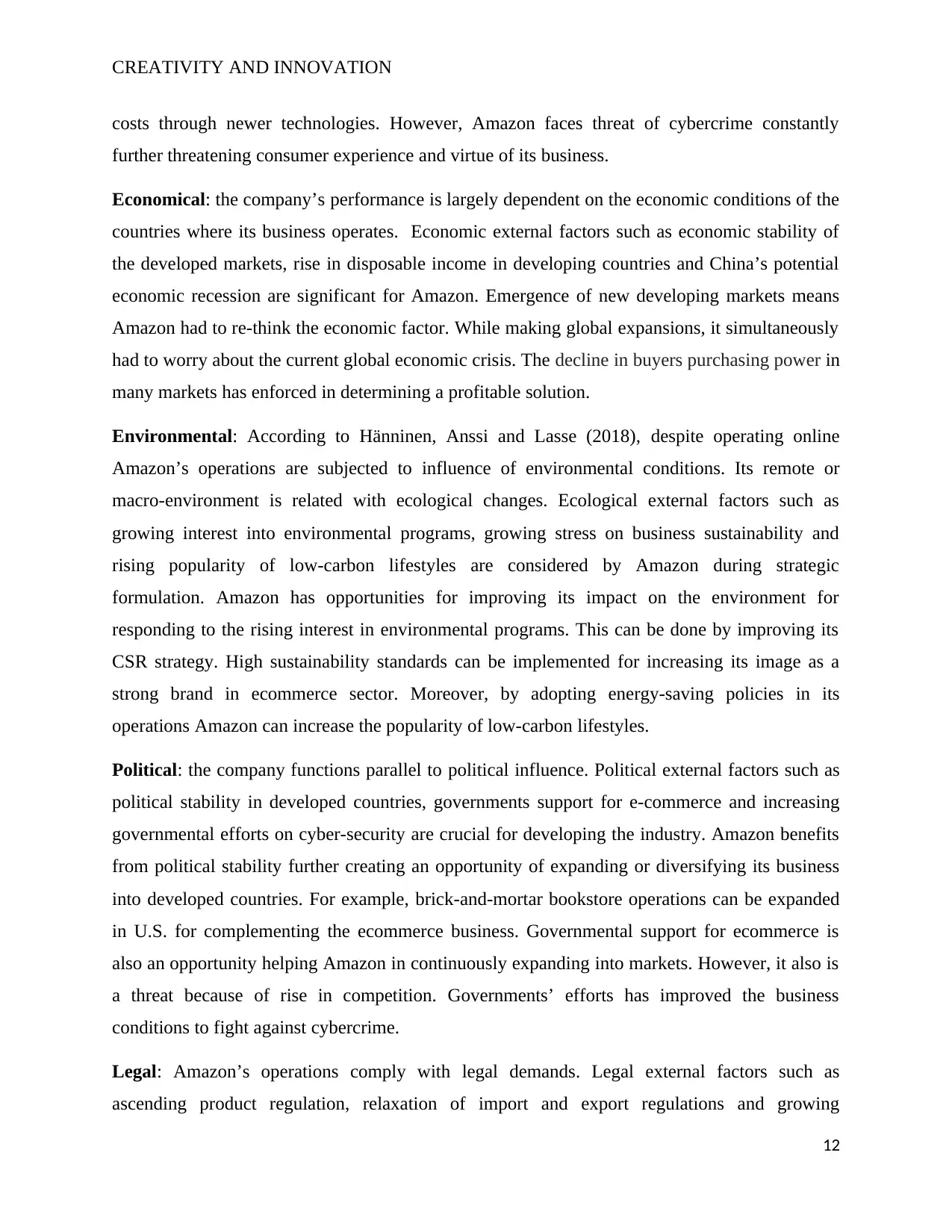
CREATIVITY AND INNOVATION
costs through newer technologies. However, Amazon faces threat of cybercrime constantly
further threatening consumer experience and virtue of its business.
Economical: the company’s performance is largely dependent on the economic conditions of the
countries where its business operates. Economic external factors such as economic stability of
the developed markets, rise in disposable income in developing countries and China’s potential
economic recession are significant for Amazon. Emergence of new developing markets means
Amazon had to re-think the economic factor. While making global expansions, it simultaneously
had to worry about the current global economic crisis. The decline in buyers purchasing power in
many markets has enforced in determining a profitable solution.
Environmental: According to Hänninen, Anssi and Lasse (2018), despite operating online
Amazon’s operations are subjected to influence of environmental conditions. Its remote or
macro-environment is related with ecological changes. Ecological external factors such as
growing interest into environmental programs, growing stress on business sustainability and
rising popularity of low-carbon lifestyles are considered by Amazon during strategic
formulation. Amazon has opportunities for improving its impact on the environment for
responding to the rising interest in environmental programs. This can be done by improving its
CSR strategy. High sustainability standards can be implemented for increasing its image as a
strong brand in ecommerce sector. Moreover, by adopting energy-saving policies in its
operations Amazon can increase the popularity of low-carbon lifestyles.
Political: the company functions parallel to political influence. Political external factors such as
political stability in developed countries, governments support for e-commerce and increasing
governmental efforts on cyber-security are crucial for developing the industry. Amazon benefits
from political stability further creating an opportunity of expanding or diversifying its business
into developed countries. For example, brick-and-mortar bookstore operations can be expanded
in U.S. for complementing the ecommerce business. Governmental support for ecommerce is
also an opportunity helping Amazon in continuously expanding into markets. However, it also is
a threat because of rise in competition. Governments’ efforts has improved the business
conditions to fight against cybercrime.
Legal: Amazon’s operations comply with legal demands. Legal external factors such as
ascending product regulation, relaxation of import and export regulations and growing
12
costs through newer technologies. However, Amazon faces threat of cybercrime constantly
further threatening consumer experience and virtue of its business.
Economical: the company’s performance is largely dependent on the economic conditions of the
countries where its business operates. Economic external factors such as economic stability of
the developed markets, rise in disposable income in developing countries and China’s potential
economic recession are significant for Amazon. Emergence of new developing markets means
Amazon had to re-think the economic factor. While making global expansions, it simultaneously
had to worry about the current global economic crisis. The decline in buyers purchasing power in
many markets has enforced in determining a profitable solution.
Environmental: According to Hänninen, Anssi and Lasse (2018), despite operating online
Amazon’s operations are subjected to influence of environmental conditions. Its remote or
macro-environment is related with ecological changes. Ecological external factors such as
growing interest into environmental programs, growing stress on business sustainability and
rising popularity of low-carbon lifestyles are considered by Amazon during strategic
formulation. Amazon has opportunities for improving its impact on the environment for
responding to the rising interest in environmental programs. This can be done by improving its
CSR strategy. High sustainability standards can be implemented for increasing its image as a
strong brand in ecommerce sector. Moreover, by adopting energy-saving policies in its
operations Amazon can increase the popularity of low-carbon lifestyles.
Political: the company functions parallel to political influence. Political external factors such as
political stability in developed countries, governments support for e-commerce and increasing
governmental efforts on cyber-security are crucial for developing the industry. Amazon benefits
from political stability further creating an opportunity of expanding or diversifying its business
into developed countries. For example, brick-and-mortar bookstore operations can be expanded
in U.S. for complementing the ecommerce business. Governmental support for ecommerce is
also an opportunity helping Amazon in continuously expanding into markets. However, it also is
a threat because of rise in competition. Governments’ efforts has improved the business
conditions to fight against cybercrime.
Legal: Amazon’s operations comply with legal demands. Legal external factors such as
ascending product regulation, relaxation of import and export regulations and growing
12
⊘ This is a preview!⊘
Do you want full access?
Subscribe today to unlock all pages.

Trusted by 1+ million students worldwide
1 out of 24
Related Documents
Your All-in-One AI-Powered Toolkit for Academic Success.
+13062052269
info@desklib.com
Available 24*7 on WhatsApp / Email
![[object Object]](/_next/static/media/star-bottom.7253800d.svg)
Unlock your academic potential
Copyright © 2020–2025 A2Z Services. All Rights Reserved. Developed and managed by ZUCOL.





